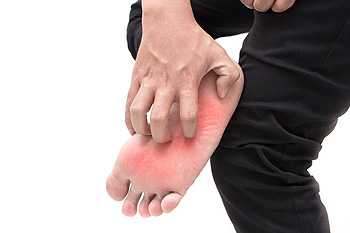Oceanside (760) 630-9200
Is Athlete’s Foot Contagious?
Monday, 14 January 2019 00:00 A fungal infection of the skin that typically affects the feet is known as athlete’s foot. The name originated from people who are active in sports because their socks and shoes tend to be sweaty from participating in their chosen sport, despite the fact it can occur in anyone. There are several symptoms that are associated with this contagious foot condition, including mild to severe itching, redness, soreness, and a general uncomfortable feeling in the feet. The fungus that causes athlete’s foot lives and thrives in warm and moist places, and these may include public pools, locker rooms, showers and surrounding areas. If athlete’s foot is left untreated, it may lead to infection, and it’s important to know how this ailment may be prevented. This may be accomplished by wearing appropriate shoes in public areas, washing and drying the feet daily, and using anti-fungal powder frequently, which may help to eliminate or reduce excess sweat. If you are afflicted with this condition, it is suggested to consult with a podiatrist, so proper treatment can begin.
A fungal infection of the skin that typically affects the feet is known as athlete’s foot. The name originated from people who are active in sports because their socks and shoes tend to be sweaty from participating in their chosen sport, despite the fact it can occur in anyone. There are several symptoms that are associated with this contagious foot condition, including mild to severe itching, redness, soreness, and a general uncomfortable feeling in the feet. The fungus that causes athlete’s foot lives and thrives in warm and moist places, and these may include public pools, locker rooms, showers and surrounding areas. If athlete’s foot is left untreated, it may lead to infection, and it’s important to know how this ailment may be prevented. This may be accomplished by wearing appropriate shoes in public areas, washing and drying the feet daily, and using anti-fungal powder frequently, which may help to eliminate or reduce excess sweat. If you are afflicted with this condition, it is suggested to consult with a podiatrist, so proper treatment can begin.
Athlete’s Foot
Athlete’s foot is often an uncomfortable condition to experience. Thankfully, podiatrists specialize in treating athlete’s foot and offer the best treatment options. If you have any questions about athlete’s foot, consult with Dr. Jeff Brooks from Oceanside Foot & Ankle Center. Our doctor will assess your condition and provide you with quality treatment.
What Is Athlete’s Foot?
Tinea pedis, more commonly known as athlete’s foot, is a non-serious and common fungal infection of the foot. Athlete’s foot is contagious and can be contracted by touching someone who has it or infected surfaces. The most common places contaminated by it are public showers, locker rooms, and swimming pools. Once contracted, it grows on feet that are left inside moist, dark, and warm shoes and socks.
Prevention
The most effective ways to prevent athlete’s foot include:
- Thoroughly washing and drying feet
- Avoid going barefoot in locker rooms and public showers
- Using shower shoes in public showers
- Wearing socks that allow the feet to breathe
- Changing socks and shoes frequently if you sweat a lot
Symptoms
Athlete’s foot initially occurs as a rash between the toes. However, if left undiagnosed, it can spread to the sides and bottom of the feet, toenails, and if touched by hand, the hands themselves. Symptoms include:
- Redness
- Burning
- Itching
- Scaly and peeling skin
Diagnosis and Treatment
Diagnosis is quick and easy. Skin samples will be taken and either viewed under a microscope or sent to a lab for testing. Sometimes, a podiatrist can diagnose it based on simply looking at it. Once confirmed, treatment options include oral and topical antifungal medications.
If you have any questions, please feel free to contact our office located in Oceanside, CA . We offer the newest diagnostic and treatment technologies for all your foot care needs.





